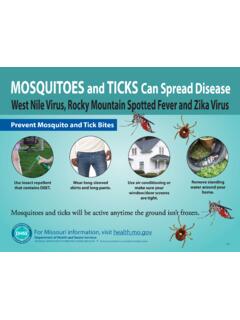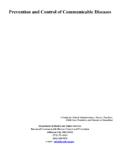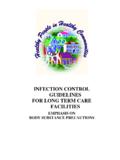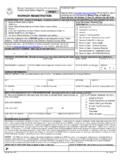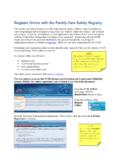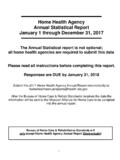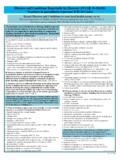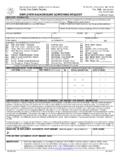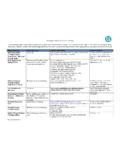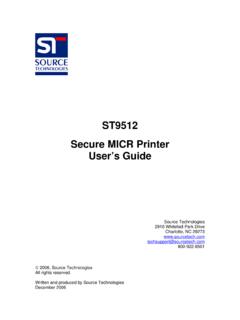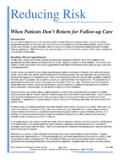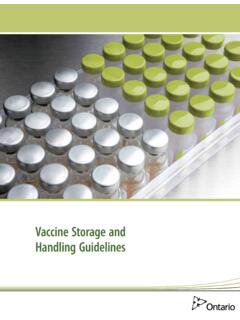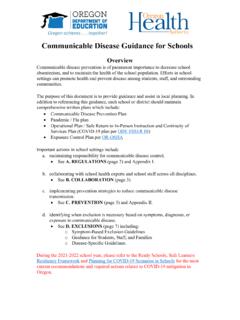Transcription of Vaccine Hesitancy and Alternative Vaccine Schedules
1 Vaccine Hesitancy and Alternative Vaccine Schedules Kristen A. Feemster, MD MPH MSHP Assistant Professor of Pediatrics, Division of Infectious Diseases Research Director, Vaccine Education Center The Children s Hospital of Philadelphia; U. of Pennsylvania School of Medicine April 21, 2016 Presenter Disclosures Consultant/ Speakers bureaus No Disclosures Research funding Agency for Healthcare Research and Quality National Institutes of Health Stock ownership/Corporate boards-employment No Disclosures Off-label uses No Disclosures Objectives Explore factors that contribute to Vaccine Hesitancy Review evidence related to the safety of the currently recommended Vaccine schedule Review common questions and misperceptions among parents that contribute to requests for Alternative Vaccine Schedules Explore strategies for addressing Vaccine concerns 2016 Vaccine schedule Impact of Vaccines Item #P4037 (12/14) MMWR August 28, 2015 / 64(33)
2 Epidemiology of Vaccine Refusal Majority of physicians report >1 Vaccine refusal / month >90% report request to spread out vaccines 1 out of 5 report that at least 10% of parents make request 13% children under-vaccinated due to parental choice Glanz JM JAMA Pediatr. 2013;167(3):274-281; Gowda, etal. Hum Vac Imm, 2013; Kempe A Pediatrics. 2015 Epidemiology of Vaccine Refusal HPV Vaccine Rates Low Compared to Other Adolescent Vaccines National Estimated Vaccination Coverage Levels among Adolescents 13-17 Years, NIS-Teen 2006-2014 MMWR July 2015 Pediatricians and Delayed Schedules Growing number of pediatricians always / often accept requests for delay (13 37%) <10% agree with parents who make requests Likelihood of accepting requests associated with beliefs about the Vaccine schedule Providers may overestimate parental concerns about # of shots Kempe A.
3 Pediatrics, 2015; Wallace etal, Vaccine 2014 A consequence of success Low perceived risk of VPD s and underappreciation of transmission risks Underappreciation of disease severity Easy access to misinformation persistent Vaccine safety concerns Concerns about disease risk Concerns about Vaccine safety A consequence of success and changing times Distrust and scientific denialism Rapid dissemination of information Naturalism Changes in Decision-making Distortion of risk Defining Vaccine Hesitancy WHO Strategic Advisory Group of Experts on Immunization and the National Vaccine Advisory Committee established Vaccine Hesitancy working groups Define Vaccine Hesitancy Model Determinants of Vaccine Hesitancy Identify Strategies to Measure and Address Hesitancy SAGE Model CONFIDENCE Contextual Influences Media History
4 Politics Individual / Group Influences Health beliefs Social Norms Perceived Risk Vaccine Specific Issues Cost schedule Delivery Adapted from MacDonald NE, SAGE Working Group on Vaccine Hesitancy ; Vaccine 33 (2015). The spectrum of Vaccine acceptance Worried ( ) Fence Sitter (13%) Go along to get along (26%) Health advocate (25%) Immunization Advocate (33%) Gust DA, et al. Am J Health Behavior, 2005,29; Leask J, etal. BMC Pediatrics. 2012, 12. Refuser (<2%) Late / Selective Vaccinator (2-27%) The hesitant (20-30%) Cautious Acceptor (25-35%) Unquestioning Acceptor (30-40%) WHY PARENTS REFUSE OR DELAY VACCINES FOR THEIR CHILDREN: ADDRESSING COMMON MISPERCEPTIONS Too many shots Isn t natural immunity better? Pharmaceutical companies are just pushing vaccines to make money Too many preservatives We never see this disease anymore I want to decide what is best for my child That Vaccine hasn t been around long enough yet Why do parents request Alternative Vaccine Schedules ?
5 Vaccine safety concerns about long term side effects or specific outcomes like autism Low perceived risk of child contracting a Vaccine preventable disease Concern that vaccination will affect immune system Parents desire to be involved in child s medical care Concerns about Vaccine additives Concerns about fever, pain associated with vaccination Are all of these vaccines too much for the immune system, especially in babies? The schedule has Year Vaccines # shots by 2 years of age # shots at one time 1900 Smallpox 1 1 1980 DTwP, Polio (OPV) MMR 5 2 2011 DTaP, Polio (IPV) MMR, Varicella Hib, Pneumococcal conj. Hepatitis A and B Influenza, Rotavirus 26 5 Fewer immunologic components are in vaccines today than 100 years ago Number of antigens in vaccines Year Vaccines # shots by age 2 yrs # shots at one time # antigens 1900 Smallpox 1 1 200 1980 Diptheria Tetanus Pertussis (wc) Polio (OPV) Measles Mumps Rubella 5 2 1 1 3,000 15 10 9 5 ~3,041 Year Vaccines # shots by age 2 yrs # shots at one time # antigens 2012 Diptheria Tetanus Pertussis (ac) Polio (IPV) MMR Varicella Hib Pneumococcal conj.
6 Hepatitis A and B Influenza Rotavirus 26 5 1 1 2-5 15 24 69 2 8 5 8 15 ~150-153 Number of antigens in vaccines That still seems like a lot - can infants handle 150 antigens? From birth, infants are challenged by bacteria in the environment (colonizing bacteria on intestines, skin, and throat; bacteria inhaled on dust). Vigorous sIgA responses within the first week of life keeps colonizing bacteria from invading. Are infants too young to be vaccinated? Excellent immune responses to HBV vaccines given at birth. About 95% of infants will develop protective immune responses to HepB, Hib, DTaP, polio, and pneumococcal vaccines by 6 months of age. Need to be fully immunized against certain infections (Hib, pertussis, pneumococcus) by 6 months of age. This just seems like too many shots at one time- why can t I spread them out?
7 Spreading put shots does not reduce stress for infant Study showing that two shots are not more likely to induce cortisol (as a marker for stress) than one shot. Antigen load from Vaccine is MUCH smaller than what an infant confronts every day in the environment Ramsay DS, Lewis M. Developmental changes in infant cortisol and behavioral response to inoculation. Child Development 1994;65;1491-1502. Are Alternative Vaccine Schedules safer? Alternative Schedules have NOT been evaluated for safety and efficacy IOM report supports safety of currently recommended schedule What about all of the additives in vaccines? Aluminum? Thimerosal? The Alternative schedule suggests only one aluminum containing Vaccine at a time in infant years. By spreading out the shots, you spread out the exposure so infants can process the aluminum without it reaching toxic levels.
8 Robert Sears, The Vaccine Book, p. 239 Aluminum and Thimerosal Aluminum is the third most abundant element on the earth s surface and the most abundant metal Occurs naturally in teas, herbs, and spices Added to foods such as leavening agents, anti-caking agents, emulsifiers, and coloring agents Thimerosal contains mercury (ethylmercury) which is also everywhere including food and water sources Aluminum and mercury in food Aluminum and mercury are found in breast milk and infant formulas. By 6 months of age infants ingest: 10mg aluminum from breast milk and 30mg from infant formula compared to 4mg from vaccines 400 g mercury from breast milk compared to <200 g from vaccines Ethylmercury is readily excreted from body- breastmilk, fish and other food sources contain methylmercury which is more likely to accumulate The dose makes the poison Aluminum can cause encephalopathy, osteomalacia and anemia in severely premature infants and patients on chronic dialysis.
9 Circulating levels of aluminum in those with symptoms between 100-1,000 ng/ml. Typically, children and adults have between 1-5 ng/ml of aluminum in blood. Injected vaccines do not raise that level. The dose makes the poison Thimerosal removed from vaccines in 2001 Now only in multidose preparations of inactivated influenza vaccines No evidence of mercury toxicity among children who received thimerosal-containing vaccines in multiple studies Everyone has small quantities heavy metals in body Can you really be sure that vaccines don t cause autism? Vaccines and autism Sparked by 1998 publication in The Lancet by Wakefield, etal linking autism and MMR Vaccine causes bowel inflammation letting brain-damaging proteins circulate Study retracted and findings refuted by multiple studies that have shown no evidence of this link1 Concern shifted to thimerosal and mercury No link found in multiple studies AND even after thimerosal removed from vaccines, autism rates have increased Dales, etal.
10 JAMA 2001; D Souza etal. Pediatrics 2006; Farrington, etal. Vaccine 2001; Madsen etal, NEJM 2002, Taylor, etal. BMJ 2002; Taylor, etal. Lancet 1999. Has evidence removed concern? Why do parents refuse or delay HPV vaccines? Reasons for not vaccinating (females), NIS-Teen 2008-131 2008 2009 2010 2013 Not recommended 13% Not needed / not necessary Lack of knowledge Safety concerns Not sexually active 1 Darden P, etal. Pediatrics 2013; MMWR 2014 My child doesn t need HPV Vaccine yet No benefit in waiting to initiate or complete the HPV Vaccine vaccination ensures protection before exposure HPV vaccines work most effectively when given prior to exposure No matter when your child becomes sexually active, young adults are at highest risk of HPV infection HPV vaccines give strongest immune response in younger adolescents HPV vaccination can be administered as part of the adolescent Vaccine platform 1 Pedersen C, JAH 2007, Reisinger KS etal, PIDJ 2007 Addressing parental concerns: Let s talk about sex?
